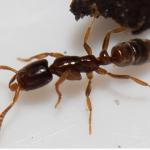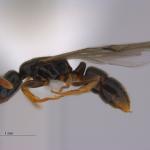Hypoponera ergatandria (previously named H. schauinslandi (Emery) (Seifert, 2013)) is a small brown ant with a functioning sting, a single substantial petiole and a constriction between the first and second segments of the gaster. It is an underground species with wingless worker-like males and only the alate gynes are likely to be seen above ground. This is a cosmopolitan tramp species which is most often come across in greenhouses and other permanently heated buildings. It has only occasionally been recorded in Britain (Seifert 2003). It is a little smaller than H. punctatissima (Roger) and can be separated in the gynes by measuring head width and scape length. It has a tropical or sub-tropical origin and cannot survive outdoors in Britain. It has an unusual flight period of November to February which is thought to be triggered by short day length although winged gynes have been know to emerge as early as August from some sites.
Isolated records from England.
A cosmopolitan species distributed throughout Europe, the tropics and sub-tropics.
This species is not regarded as scarce or threatened.
Seifert (2013) gives a method of separating the species based on measurements of the head width and scape length. The input of data has to be in millimetres and accurate for three decimal points. For Head width, CW and Scape length, SL:
If SL/CW > 0.88 you have H. eduardi
else
For workers and ergatomorphic females calculate the function D = 142.82 SL – 68.67 CW –26.12 Specimens with D<0 belong to H. ergatandria and those with D>0 to H. punctatissima.
For gynomorphic females calculate the function D = 85.90 SL – 18.54 CW – 30.312 Specimens with D<0 belong to H. ergatandria and those with D>0 to H. punctatissima.
This species has been found in greenhouses and buildings that are permanently heated and rarely from outdoors.
November to February typically
Colonies are underground and can be polydomous usually containing several queens, a few males and around 200 workers.
Feeds on very small soil living arthropods.
2021



